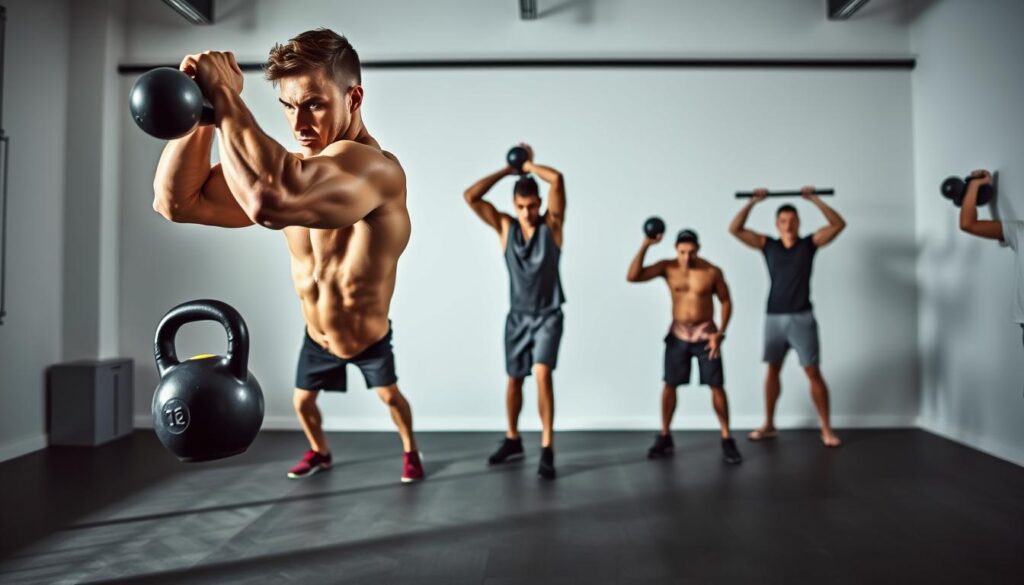Blog
No Gym, No Problem: The Ultimate Full-Body Bodyweight Workout Plan

Getting fit doesn’t require a gym membership or expensive equipment. With bodyweight exercises, you can achieve a full-body workout from the comfort of your own home.
Calisthenics for beginners is an excellent way to start your fitness journey, improving strength, flexibility, and overall health. An at-home workout routine can be tailored to your needs and schedule, making it easier to stick to your goals.
By incorporating simple yet effective exercises into your daily routine, you can transform your body and improve your overall well-being. Whether you’re a beginner or an experienced fitness enthusiast, this ultimate full-body workout plan is designed to help you achieve your fitness goals.
Key Takeaways
- Get fit without a gym membership using bodyweight exercises.
- Improve strength, flexibility, and overall health with calisthenics.
- Create a personalized at-home workout routine to suit your needs.
- Achieve a full-body workout with simple yet effective exercises.
- Transform your body and improve overall well-being.
Why Bodyweight Training Is Effective
The effectiveness of bodyweight training lies in its ability to engage multiple muscle groups simultaneously, promoting overall strength and flexibility. This form of exercise leverages the individual’s own weight to provide resistance, which is essential for building strength and muscle.
The Science Behind Resistance Training
Resistance training, such as bodyweight exercises, is grounded in the principle of progressive overload. By gradually increasing the difficulty of exercises, individuals can continue to challenge their muscles, leading to improvements in strength and muscle mass. Bodyweight training is a form of resistance training that utilizes the body’s weight as the primary resistance.
Benefits for Strength, Endurance, and Flexibility
Bodyweight exercises offer a multitude of benefits, including:
- Increased strength through resistance exercises like push-ups and squats
- Improved endurance as the body adapts to perform more repetitions
- Enhanced flexibility due to the range of motion required in many bodyweight exercises
These benefits combine to create a well-rounded fitness regimen that improves overall physical fitness.

Accessibility and Convenience Factors
One of the most significant advantages of bodyweight training is its accessibility. With no need for specialized equipment or a gym membership, individuals can work out anywhere, at any time. This convenience factor makes it easier for people to stick to their workout routines, leading to more consistent progress and results.
By incorporating bodyweight exercises into their routine, individuals can achieve significant improvements in strength, endurance, and flexibility, all without the need for any equipment.
Equipment-Free Fitness: What You Really Need
Starting a bodyweight workout routine requires minimal equipment, but a well-prepared space is essential. The beauty of at-home workouts lies in their flexibility and convenience.
Minimal Space Requirements
You don’t need a large area to start your bodyweight training. A small, clear space of about 6 feet by 6 feet is sufficient for most progressive exercises. Ensure the floor is clear of obstacles and has a non-slippery surface.
Optional Accessories to Enhance Your Workouts
While not necessary, some accessories can enhance your workout experience. These include:
- A yoga mat for comfort and grip
- Resistance bands for added resistance
- A pull-up bar for upper body exercises
Creating an Effective Workout Environment
To maximize your workout, create an environment that fosters focus and motivation. This can be achieved by:
- Ensuring good ventilation and lighting
- Minimizing distractions
- Using a mirror to check your form
By focusing on these elements, you can create an effective and motivating at-home workout space that supports your fitness journey.
The Complete Guide to Bodyweight Exercises
Functional strength, improved body composition, and enhanced mobility are just a few benefits of incorporating bodyweight exercises into your routine. Bodyweight training engages multiple muscle groups simultaneously, providing a comprehensive workout that improves overall physical fitness.
Functional Strength Development
Bodyweight exercises are designed to improve functional strength, which is essential for everyday activities. By mimicking natural movements, these exercises help build strength that is applicable to real-life situations.
- Improves coordination and balance
- Enhances muscular endurance
- Increases overall physical fitness
Improved Body Composition
Regular bodyweight training can lead to significant improvements in body composition. By building lean muscle and reducing body fat, individuals can achieve a healthier, more toned physique.
“Bodyweight exercises are an effective way to improve body composition by building lean muscle and increasing metabolism.”
Enhanced Mobility and Balance
Bodyweight exercises often require a range of motion, which helps improve flexibility and mobility. Additionally, many exercises demand balance and stability, further enhancing overall physical ability.
Injury Prevention Benefits
By strengthening muscles and improving flexibility, bodyweight exercises can help prevent injuries. This is particularly beneficial for individuals who engage in sports or other physical activities.
Key benefits include:
- Reduced risk of injury
- Improved joint health
- Enhanced overall resilience
In conclusion, bodyweight exercises offer a wide range of benefits that can enhance overall fitness and well-being. By incorporating these exercises into your routine, you can improve functional strength, body composition, mobility, and balance, while also reducing the risk of injury.
Getting Started: Proper Form and Technique
Proper technique is the foundation of a successful bodyweight workout routine. When you focus on correct form, you not only maximize the effectiveness of your exercises but also significantly reduce the risk of injury. This foundational knowledge is crucial for building muscle with no equipment and achieving your fitness goals.
Body Alignment Fundamentals
Maintaining correct body alignment is essential for effective bodyweight exercises. This involves ensuring that your body is positioned correctly in relation to the direction of the movement. For instance, during a push-up, your body should form a straight line from head to heels. Proper alignment helps in targeting the correct muscles and prevents unnecessary strain on your joints.
Common Mistakes to Avoid
One of the most common mistakes in bodyweight training is sacrificing form for the sake of completing more repetitions. This can lead to injuries and reduce the effectiveness of your workout. For example, arching your back during a squat can put undue stress on your spine. Being aware of these common mistakes can help you avoid them and maintain progressive exercises over time.
How to Self-Check Your Form
Self-checking your form involves being mindful of your body position and movement during exercises. Using a mirror or recording yourself can help identify any deviations from proper form. Additionally, working out with a partner who can provide feedback is beneficial.
When to Modify Exercises
Knowing when to modify exercises is crucial for progressing in your bodyweight training. If you’re finding it difficult to maintain proper form, it may be necessary to modify the exercise to make it more manageable. Conversely, if an exercise becomes too easy, you can modify it to increase the challenge. This progressive approach is key to continuous improvement.
| Exercise | Proper Form Indicator | Modification |
|---|---|---|
| Push-up | Body in a straight line | Knee push-up |
| Squat | Knees behind toes | Half squat |
| Plank | Core engaged | Wall plank |
By focusing on proper form and technique, you can ensure a safe and effective bodyweight workout routine that supports your fitness goals.
The Foundation: Essential Bodyweight Exercises
Effective bodyweight training relies on a foundation of exercises that work multiple muscle groups. Mastering these essential exercises is crucial for a well-rounded at-home workout that improves strength, endurance, and flexibility.
Upper Body Movements
Upper body exercises are vital for building strength and improving overall muscle tone. These exercises can be modified to suit different fitness levels, ensuring a challenging workout for everyone.
Push-Up Variations
Push-ups are a fundamental upper body exercise that targets the chest, shoulders, and triceps. Variations like diamond push-ups and decline push-ups add diversity to your workout.
Pull-Up Alternatives
For those without access to a pull-up bar, alternatives like inverted rows and assisted pull-ups can be just as effective. These exercises target the back and arm muscles.
Dips and Shoulder Exercises
Dips are excellent for building tricep strength, while shoulder exercises like wall slides improve mobility and strength in the shoulder muscles.
Lower Body Exercises
Lower body exercises are essential for building strength, improving balance, and enhancing overall lower body strength.
Squat Variations
Squats are a foundational exercise that targets the legs and glutes. Variations like sumo squats and single-leg squats add challenge and diversity.
Lunge Patterns
Lunges are effective for targeting the legs and improving balance. Walking lunges and side lunges are examples of variations that challenge different muscle groups.
Calf and Hamstring Work
Calf raises and hamstring curls are crucial for building strength in the lower legs. These exercises can be done with bodyweight or modified with additional resistance.
| Exercise | Primary Muscle Group | Secondary Muscle Group |
|---|---|---|
| Push-Up | Chest | Shoulders, Triceps |
| Squat | Legs | Glutes, Core |
| Lunge | Legs | Glutes, Core |
| Plank | Core | Shoulders, Back |
Core Strengthening Movements
Core exercises are vital for improving stability, balance, and overall athletic performance. A strong core enhances the effectiveness of other exercises.
Plank Progressions
Planks are a fundamental core exercise that targets the abs and improves overall core strength. Progressions like side planks and plank jacks add variety.
Dynamic Core Exercises
Dynamic exercises like Russian twists and leg raises challenge the core muscles dynamically, improving rotational strength and flexibility.
The 4-Week Progressive Workout Plan
Embarking on a fitness journey can be daunting, but with a structured 4-week progressive workout plan, you can achieve significant results without stepping foot in a gym. This plan is designed to progressively challenge your body, enhancing strength, endurance, and flexibility through calisthenics for beginners.
Week 1: Building the Foundation
The first week focuses on establishing a solid foundation through basic bodyweight exercises. It’s crucial to master the proper form and technique to avoid injuries and ensure effective workouts.
Day-by-Day Workout Schedule
- Monday: Upper body workout (push-ups, tricep dips)
- Tuesday: Lower body workout (squats, lunges)
- Wednesday: Rest day
- Thursday: Core workout (plank, Russian twists)
- Friday: Full-body workout (burpees, mountain climbers)
- Saturday & Sunday: Rest days
Exercise Demonstrations
Proper form is key to effective workouts. For example, in push-ups, ensure your body is in a straight line from head to heels, and lower yourself until your chest nearly touches the ground.
Week 2: Increasing Intensity
In the second week, we increase the intensity by adding more repetitions and introducing new exercises that target different muscle groups.
Progressive Workout Structure
The workouts become more challenging as we progress. For instance, you might move from standard push-ups to diamond push-ups to increase the difficulty.
Key Focus Areas
- Increasing reps and sets
- Introducing new exercises like pull-ups and calf raises
- Enhancing core strength with more dynamic movements
Week 3: Adding Complexity
By the third week, you’ll be ready to incorporate more complex movements that require coordination and higher levels of strength and endurance.
Advanced Movement Patterns
Exercises like plyometric squats and plank jacks are introduced to boost your workout intensity and challenge your body in new ways.
Intensity Techniques
Techniques such as supersets and circuit training are employed to maximize calorie burn and improve cardiovascular health.
Week 4: Maximizing Results
The final week is all about maximizing your results. You’ll be pushing your limits with high-intensity workouts designed to enhance your strength, endurance, and flexibility.
Peak Week Training
This involves the most challenging workouts yet, with a focus on full-body exercises and high-intensity interval training (HIIT).
Performance Assessment
Assess your progress by tracking your workouts, noting improvements in strength, endurance, and overall fitness.
| Week | Focus | Sample Exercises |
|---|---|---|
| 1 | Building Foundation | Push-ups, Squats |
| 2 | Increasing Intensity | Diamond Push-ups, Calf Raises |
| 3 | Adding Complexity | Plyometric Squats, Plank Jacks |
| 4 | Maximizing Results | Burpees, Mountain Climbers |
Structuring Your Workouts for Maximum Results
To achieve maximum results from your at-home workout, it’s crucial to structure your bodyweight training sessions effectively. A well-structured workout routine helps in optimizing the time spent on exercising and ensures that you’re targeting all major muscle groups.
Optimal Exercise Sequencing
Sequencing your exercises correctly can significantly impact your workout’s effectiveness. Typically, it’s recommended to start with compound exercises that work multiple muscle groups at once, followed by isolation exercises that target specific muscles.
Rest Periods and Recovery
Adequate rest and recovery are crucial for muscle growth and repair. Ensuring you have sufficient rest periods between sets and allowing for recovery days in your workout schedule can enhance your overall performance.
Frequency and Scheduling
Determining the right frequency for your workouts depends on your fitness goals and current fitness level. For most individuals, working out 3-4 times a week is sufficient for maintaining a good balance between exercise and recovery.
Balancing Intensity and Volume
Balancing the intensity of your workouts with the volume is key to avoiding burnout and preventing overtraining. Increasing intensity or volume too quickly can lead to injury, so it’s essential to progress gradually.
| Workout Aspect | Recommendation | Benefits |
|---|---|---|
| Exercise Sequencing | Start with compound exercises | Works multiple muscle groups, efficient |
| Rest Periods | Allow 60-90 seconds between sets | Enhances recovery, improves performance |
| Workout Frequency | 3-4 times per week | Balances exercise and recovery, sustainable |
| Intensity and Volume | Progress gradually | Reduces risk of injury, promotes long-term progress |
Progressive Overload Without Weights
To continue making progress in bodyweight exercises, understanding progressive overload is essential. Progressive overload refers to the gradual increase in the intensity, frequency, or duration of exercise to achieve greater fitness gains. In the context of bodyweight training, this means challenging your muscles in new and demanding ways without relying on external weights.
Increasing Repetitions and Sets
One of the simplest ways to achieve progressive overload is by increasing the number of repetitions or sets of an exercise. For instance, if you’re doing push-ups, you could start with 3 sets of 10 reps and gradually increase to 4 sets of 15 reps as you build strength.
Adjusting Leverage and Angles
Another effective method is to adjust the leverage or angle of your body to make exercises more challenging. For example, changing from a standard push-up to a diamond push-up or a decline push-up can significantly increase the difficulty.
As noted by fitness expert,
“The key to progressive overload is to challenge your muscles in new ways. This can be achieved through various techniques, including changing the angle of your body or increasing the tempo of your exercises.”
Adding Tempo and Isometric Holds
Adding tempo variations or incorporating isometric holds can also enhance the challenge of bodyweight exercises. For example, slowing down the tempo of a squat or adding a pause at the bottom can increase the time your muscles are under tension.
Implementing Advanced Variations
Finally, implementing advanced variations of exercises is a powerful way to achieve progressive overload. This could involve moving from a basic exercise to a more complex version, such as progressing from a standard plank to a side plank or a dynamic plank variation.
| Exercise | Basic Version | Advanced Version |
|---|---|---|
| Push-up | Standard Push-up | Diamond Push-up, Decline Push-up |
| Squat | Bodyweight Squat | Single-Leg Squat, Pistol Squat |
| Plank | Standard Plank | Side Plank, Dynamic Plank |
By incorporating these progressive overload techniques into your bodyweight training routine, you can continue to challenge your muscles and achieve significant strength gains over time.
Tracking Progress and Staying Motivated
As you embark on your calisthenics journey, monitoring your progress and staying motivated are essential for achieving your fitness goals. A well-structured at-home workout plan is just the beginning; consistent tracking and motivation will drive you towards success.
Effective Metrics to Monitor
To gauge your progress effectively, focus on metrics such as workout completion rates, increases in exercise repetitions, and improvements in overall endurance. These metrics provide a clear picture of your advancement.
- Workout completion rates
- Increases in exercise repetitions
- Improvements in overall endurance
Setting Realistic Milestones
Setting achievable milestones is crucial for maintaining motivation. Break down larger goals into smaller, manageable objectives, and celebrate each success along the way.
Building Consistency Through Habits
Consistency is key to seeing results in your at-home workout. Develop a routine and stick to it, making adjustments as needed to avoid plateaus.
Community and Accountability Resources
Joining a community or finding an accountability partner can significantly boost your motivation. Look for online forums, social media groups, or local fitness communities to support your journey.
By implementing these strategies, you’ll be well on your way to achieving your fitness goals and maintaining a sustainable fitness lifestyle.
Nutrition to Support Your Bodyweight Training
To maximize the benefits of bodyweight training, it’s essential to support your workouts with the right nutrition. A well-balanced diet not only fuels your workouts but also aids in recovery and muscle growth.
Protein Requirements for Muscle Growth
Protein is a critical component of a bodyweight training diet, especially when your goal is to build muscle with no equipment. Consuming enough protein helps repair and grow muscle tissue. Aim for about 1.2 to 1.6 grams of protein per kilogram of body weight daily. For example, if you weigh 70 kilograms, your daily protein intake should be between 84 to 112 grams.
For more tips on nutrition, check out this article on quick nutrition tips for fat loss.
Energy Balance for Different Goals
Your energy balance, or the difference between calories consumed and calories expended, determines whether you lose weight, gain weight, or maintain your current weight. For bodyweight training, if your goal is to lose fat, you need to be in a calorie deficit. Conversely, if you’re aiming to build muscle, you may need a calorie surplus to provide your body with enough energy to support muscle growth.
Meal Timing Around Workouts
Meal timing can significantly impact your workout performance and recovery. Eating a balanced meal with protein and carbohydrates about 1-2 hours before your workout can provide the necessary energy. Post-workout, within 30-60 minutes, consume a meal or shake that includes protein and carbs to aid in recovery.
For ideas on meal prep, visit easy meal prep ideas for a healthy.
Hydration and Recovery Nutrition
Staying hydrated is crucial for both performance and recovery. Aim to drink at least 8-10 glasses of water per day, and more if you’re sweating heavily during workouts. Additionally, consider incorporating recovery nutrition strategies such as consuming electrolyte-rich beverages or foods high in antioxidants to help reduce muscle soreness.
“As the saying goes, ‘You can’t out-train a bad diet.'” This quote emphasizes the importance of nutrition in supporting your bodyweight training regimen.
Conclusion: Building a Sustainable Fitness Lifestyle
By incorporating bodyweight exercises for strength into your daily routine, you can achieve a full-body workout from the comfort of your own home. At-home workouts offer a convenient and effective way to improve your overall fitness, and calisthenics for beginners provide a great starting point.
As you’ve learned throughout this article, a well-structured bodyweight training program can help you build strength, increase endurance, and enhance flexibility. By following the 4-week progressive workout plan and tips on progressive overload, you can continue to challenge yourself and achieve your fitness goals.
To maintain a sustainable fitness lifestyle, focus on making exercise a habit by scheduling regular At-home workouts and tracking your progress. With consistency and dedication, you can enjoy the many benefits of bodyweight training and achieve a healthier, stronger you.



